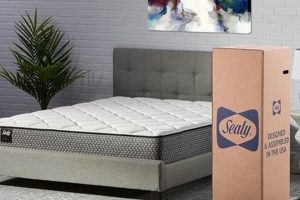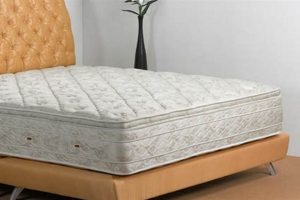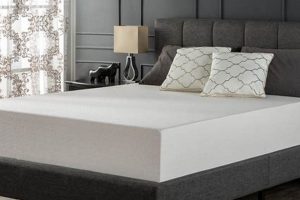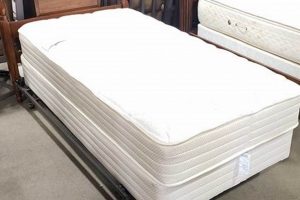A foundation designed for supporting a mattress while maintaining a minimal height is often sought to achieve a specific aesthetic or accommodate height restrictions. Such platforms offer a streamlined profile compared to traditional bed frames or box springs. For instance, a platform measuring less than eight inches is typically categorized as having a lower stance.
The appeal of diminished verticality in bed supports stems from several advantages. These include creating a more spacious feel within a room, facilitating easier access for individuals with mobility concerns, and complementing contemporary bedroom designs that favor minimalist aesthetics. Historically, taller bed frames were prevalent, but modern preferences have shifted towards less obtrusive options, resulting in the increased popularity of these lower alternatives.
The following sections will delve into the specifics of selecting an appropriate reduced-height mattress foundation, examining material choices, structural considerations, and compatibility with various mattress types. This analysis will provide a comprehensive understanding of how to choose a support system that balances aesthetic appeal with optimal mattress performance and longevity.
Tips for Choosing a Low Profile Mattress Foundation
Selecting a foundation with diminished height requires careful consideration to ensure proper support, mattress compatibility, and overall bed functionality. These tips provide guidance for making an informed decision.
Tip 1: Assess Mattress Compatibility: Verify that the selected foundation is suitable for the specific mattress type. Some mattresses, such as those containing innersprings, may require different support structures than foam or latex models. Consult the mattress manufacturer’s recommendations.
Tip 2: Evaluate Support Structure: Examine the internal framework of the foundation. Solid platforms or those with closely spaced slats provide more uniform support, minimizing potential sagging or uneven wear on the mattress. Consider the weight capacity to ensure it can adequately support the mattress and occupants.
Tip 3: Measure Bed Frame Dimensions: Accurately measure the interior dimensions of any existing bed frame. The foundation must fit snugly within the frame to prevent movement and potential damage. A foundation that is too small or too large can compromise stability and support.
Tip 4: Consider Ventilation Needs: If using a memory foam mattress, ensure the foundation allows for adequate airflow. Some solid platforms can trap heat and moisture, potentially affecting the mattress’s performance and longevity. Opt for slatted designs or those with ventilation channels to promote air circulation.
Tip 5: Prioritize Durable Materials: Choose a foundation constructed from high-quality materials, such as solid wood or reinforced steel. These materials offer superior durability and resistance to wear and tear. Avoid options made from flimsy or low-grade materials, as they may not provide adequate support over time.
Tip 6: Check for Noise Reduction Features: Some foundations can generate noise due to friction between the mattress and the frame. Look for models with fabric liners or padding on the frame to minimize squeaking or creaking sounds during movement.
These considerations will aid in selecting a foundation that not only provides adequate support and mattress compatibility but also enhances the overall sleep experience. Prioritizing quality and proper fit will contribute to the longevity of both the mattress and the foundation.
The subsequent sections will address the installation process and maintenance strategies for maintaining the performance of the chosen foundation.
1. Minimal height
Minimal height is an essential defining characteristic of a low profile mattress box. It directly influences the overall bed height, contributing to a specific aesthetic and affecting accessibility. A low profile mattress box is deliberately engineered to reduce the combined height of the bed frame, foundation, and mattress. This is achieved by minimizing the vertical dimension of the foundation itself. For example, standard box springs often range from 8 to 12 inches in height, while a low profile version typically measures between 4 to 7 inches. The selection of a low profile model can be driven by design preferences, particularly in contemporary bedrooms favoring clean lines and a lower center of gravity. The decreased height also benefits individuals with mobility limitations, facilitating easier entry and exit from the bed.
The impact of minimal height extends beyond mere aesthetics. It directly influences the perceived spaciousness of a room, particularly in smaller bedrooms. By reducing the overall bed height, more vertical space is created, contributing to a less cluttered and more open environment. Furthermore, the selection of a low profile mattress box may be dictated by pre-existing bed frames or headboards designed for lower mattress profiles. Incompatibility between a tall foundation and a low-slung headboard would result in an undesirable aesthetic. The practical application of this understanding lies in accurately assessing the dimensions of all bedroom components before purchase, ensuring harmonious integration and desired visual outcome.
In conclusion, minimal height is not merely a superficial attribute but a core design element of a low profile mattress box, influencing both aesthetics and functionality. Understanding this connection is crucial for making informed purchasing decisions, ensuring that the chosen foundation aligns with individual preferences, physical needs, and the overall design scheme of the bedroom. The continued trend toward minimalist design suggests that low profile foundations will maintain their relevance in the bedding market.
2. Platform support
Platform support is a fundamental design element directly influencing the efficacy of a low profile mattress box. Its presence or absence fundamentally determines the level of support provided to the mattress and, consequently, the user’s sleep experience. The cause-and-effect relationship is straightforward: inadequate platform support leads to mattress sagging, uneven weight distribution, and ultimately, reduced comfort and lifespan of the mattress. A low profile design inherently reduces the structural volume available for support, necessitating a carefully engineered platform to compensate. A real-life example involves cheaper, less robust low profile mattress boxes utilizing widely spaced slats that fail to adequately support heavier mattresses, resulting in premature wear and tear.
Effective platform support in a low profile configuration often involves closely spaced slats, a solid platform surface, or a combination thereof. The material composition, typically wood or metal, also contributes significantly. For instance, a low profile mattress box employing solid wood slats spaced no more than two inches apart provides a more uniform support surface compared to one with sparsely distributed, thin metal slats. The practical significance of this understanding lies in the ability to assess the load-bearing capacity and structural integrity of a low profile mattress box prior to purchase. This is crucial to avoid compromising mattress warranties and experiencing discomfort due to inadequate support.
In summary, platform support is not merely an ancillary feature but an intrinsic component of a low profile mattress box, impacting both its structural integrity and the overall sleep quality. Neglecting this aspect can lead to premature mattress degradation and user discomfort. Understanding the nuances of platform support empowers consumers to make informed decisions, ensuring the selected low profile mattress box provides adequate and lasting support for the intended mattress, aligning with the broader goal of achieving optimal sleep health and mattress longevity.
3. Slatted airflow
Slatted airflow, concerning a low profile mattress box, represents a design element critically linked to mattress health and user comfort. The restrictive nature of a reduced-height foundation increases the potential for moisture and heat accumulation within the mattress. The presence or absence of slatted airflow directly affects the ventilation beneath the mattress, influencing the microclimate within the sleep environment. A direct consequence of inadequate airflow is the potential for mold and mildew growth, compromising mattress hygiene and potentially triggering allergic reactions. A demonstrable example is a low profile solid platform, lacking any ventilation, used in conjunction with a memory foam mattress, which is known for retaining heat and moisture. This combination can result in a breeding ground for microorganisms, decreasing the mattress lifespan and increasing the risk of respiratory issues for the user. The practical significance of recognizing the importance of slatted airflow lies in selecting a foundation that actively promotes ventilation, mitigating these potential problems.
The implementation of slatted airflow in a low profile mattress box commonly involves the use of evenly spaced slats, typically constructed from wood or metal. The spacing between the slats is a crucial factor, as wider gaps provide greater ventilation but may compromise mattress support if the mattress construction is not suitable. The optimal spacing must balance airflow with adequate support to prevent sagging or uneven wear. Furthermore, some designs incorporate breathable fabric coverings or mesh materials to enhance airflow while preventing dust accumulation. The practical application of these design considerations involves carefully evaluating the slat spacing and material composition based on the specific mattress type and the individual’s sleeping habits. For example, individuals who tend to sleep hot may benefit from a foundation with wider slat spacing and breathable materials, while those with heavier mattresses may require narrower spacing to maintain adequate support.
In summary, slatted airflow is a crucial element in low profile mattress box design, significantly impacting mattress health and user well-being. The reduced vertical space inherent in low profile foundations necessitates careful consideration of ventilation to prevent moisture accumulation and microbial growth. The selection of a low profile mattress box with adequate slatted airflow represents a proactive approach to maintaining mattress hygiene, prolonging mattress lifespan, and promoting a healthier sleep environment. Ignoring this aspect can have detrimental consequences, compromising both the structural integrity of the mattress and the overall sleep experience.
4. Frame compatibility
Frame compatibility, in the context of a low profile mattress box, dictates the ability of the foundation to integrate seamlessly and function optimally within an existing bed frame structure. The cause-and-effect relationship is fundamental: a mismatch between frame dimensions and the foundation results in instability, inadequate support, and potential damage to both the mattress and the frame. The importance of frame compatibility stems from the inherent limitations of a low profile design; any dimensional discrepancies are magnified due to the reduced vertical height, making secure integration more critical than with traditional box springs. For example, a low profile mattress box that is marginally smaller than the bed frame’s interior dimensions will exhibit excessive movement, leading to uneven weight distribution and premature mattress wear. Conversely, a foundation that is too large will prevent proper frame assembly or exert undue stress on the frame joints, potentially causing structural failure. The practical significance of understanding frame compatibility lies in the ability to ensure structural integrity and longevity of the entire bed system.
Accurate measurement of the bed frame’s interior dimensions is paramount to achieving frame compatibility. This includes measuring the length, width, and depth of the frame’s support structure. The low profile mattress box should ideally fit snugly within the frame, minimizing lateral movement while avoiding excessive pressure against the frame walls. Furthermore, the presence of any obstructions within the frame, such as center support beams or protruding hardware, must be considered. Some low profile designs may be incompatible with certain bed frame configurations, necessitating the selection of an alternative foundation or modification of the frame itself. A further practical consideration involves the style of the bed frame. Platform beds, for instance, often require specific types of low profile mattress boxes designed to sit flush with the frame’s edges, while traditional frames may accommodate a wider range of foundation styles.
In summary, frame compatibility is an indispensable element in selecting a low profile mattress box, profoundly impacting the bed’s stability, support, and overall lifespan. A meticulous approach to measurement and consideration of frame design ensures a harmonious integration, preventing structural issues and optimizing the sleep experience. The challenge lies in accurately assessing the existing frame and selecting a foundation that meets the precise dimensional requirements, ultimately fostering a stable and supportive sleep environment.
5. Weight distribution
Weight distribution is a critical engineering consideration in the design and functionality of a low profile mattress box. The inherent reduction in height, compared to traditional foundations, necessitates a structurally sound design capable of evenly distributing the combined weight of the mattress and its occupants. Improper weight distribution can result in localized stress points, leading to premature mattress sagging, structural failure of the foundation, and ultimately, a compromised sleep surface. The absence of proper weight distribution mechanisms in a low profile mattress box can manifest as noticeable indentations, uneven support across the sleeping surface, and accelerated degradation of the mattress core. A typical example involves inexpensive low profile platforms constructed with widely spaced, thin slats. These structures often fail to adequately support weight, resulting in sagging and a reduced lifespan for both the mattress and the foundation. The practical significance of understanding weight distribution lies in selecting a foundation that maintains its structural integrity under load, providing consistent support and prolonging the life of the mattress.
Effective weight distribution within a low profile mattress box is achieved through various design elements. These may include a closely spaced network of slats, a solid platform surface, or a combination of both. The material selection, typically wood or metal, also plays a crucial role. High-density hardwood or reinforced steel provides superior weight-bearing capacity compared to less robust materials. The support structure must be designed to evenly disperse weight across the entire surface, minimizing stress concentrations and preventing localized deformation. For example, a low profile mattress box with a solid wood platform and reinforced edges will offer superior weight distribution compared to one with widely spaced metal slats and minimal edge support. Furthermore, the design must account for dynamic weight shifts during sleep, ensuring consistent support and preventing noise generation caused by movement.
In conclusion, weight distribution is not merely a technical specification but a fundamental performance attribute of a low profile mattress box. Adequate weight distribution ensures consistent support, promotes mattress longevity, and enhances the overall sleep experience. Neglecting this aspect can lead to premature wear, discomfort, and structural instability. By understanding the engineering principles that govern weight distribution, consumers can make informed purchasing decisions, selecting a low profile mattress box that provides reliable support and maintains its integrity over time. The challenge lies in discerning the quality of internal support structures and materials, ensuring that the chosen foundation can effectively manage weight and provide a stable, comfortable sleep surface.
6. Durable materials
The selection of durable materials is of paramount importance in the construction of a low profile mattress box, directly influencing its longevity, structural integrity, and overall value. Given the reduced vertical space inherent in these designs, the stress on individual components is often amplified, necessitating the use of robust materials capable of withstanding significant weight and repeated use.
- Wood Frame Integrity
Hardwoods, such as oak or maple, offer superior strength and resistance to warping compared to softwoods like pine. In low profile applications, a hardwood frame provides critical support to prevent sagging, especially under heavier mattresses. The selection of a robust wood species directly correlates with the foundation’s ability to maintain its shape and provide consistent support over extended periods. An example includes a low profile platform constructed from solid oak, maintaining its structural integrity after years of use, while a pine frame may exhibit noticeable deformation under similar conditions.
- Metal Support Systems
Reinforced steel provides essential support in low profile mattress boxes, particularly in the form of internal bracing and slat supports. The gauge of the steel directly influences its weight-bearing capacity and resistance to bending or fracture. Inadequate steel support can lead to premature failure of the foundation, especially under heavier mattresses or during dynamic weight shifts. For example, a low profile foundation with 14-gauge steel slats offers significantly greater support than one with 18-gauge slats, preventing sagging and ensuring even weight distribution.
- Fabric Upholstery Resilience
The fabric used to upholster a low profile mattress box is subject to constant friction and abrasion. Durable fabrics, such as tightly woven polyester blends or linen, offer superior resistance to tearing, stretching, and staining compared to less robust materials like cotton. This resilience is crucial for maintaining the aesthetic appeal and preventing premature wear of the foundation’s exterior. An example is a low profile foundation upholstered in a high-density polyester blend, resisting stains and maintaining its appearance after years of use, while a cotton-covered foundation may exhibit fading and tearing under similar conditions.
- Joint Construction Durability
The method of joining frame components significantly impacts the overall strength and longevity of a low profile mattress box. Strong joint construction, utilizing techniques such as mortise and tenon joints or reinforced metal brackets, ensures structural stability and prevents loosening or separation over time. Weak joint construction can lead to wobbling, creaking, and eventual failure of the foundation. For instance, a low profile platform with mortise and tenon joints exhibits superior strength and resistance to racking compared to one with simple butt joints held together with staples.
The interplay between these durable materials and robust construction techniques is essential for ensuring the long-term performance and value of a low profile mattress box. Prioritizing quality materials translates to a foundation that can withstand the rigors of daily use, providing consistent support, and maintaining its aesthetic appeal for years to come. Therefore, a discerning evaluation of materials and construction methods is paramount when selecting a low profile mattress box.
Frequently Asked Questions
This section addresses common inquiries regarding low profile mattress boxes, offering clarity on their design, functionality, and suitability.
Question 1: What are the primary benefits of selecting a low profile mattress box compared to a standard-height foundation?
A low profile mattress box offers a reduced overall bed height, contributing to a modern aesthetic and potentially facilitating easier access for individuals with mobility concerns. It can also be advantageous in rooms with limited vertical space.
Question 2: Does a low profile mattress box compromise mattress support due to its reduced height?
Not necessarily. While the vertical dimension is smaller, a well-designed low profile mattress box employs robust internal support structures, such as closely spaced slats or a solid platform, to provide adequate support. The specific design determines the level of support provided.
Question 3: Are all mattress types compatible with a low profile mattress box?
Compatibility depends on the specific design of the mattress box and the recommendations of the mattress manufacturer. Some mattress types, such as those with innersprings, may require specific support structures that may or may not be present in all low profile designs. Always consult the mattress manufacturer’s guidelines.
Question 4: How does a low profile mattress box affect airflow and ventilation around the mattress?
Some low profile designs, particularly solid platforms, can restrict airflow. Slatted designs are generally preferred to promote ventilation and prevent moisture accumulation, which is especially important for memory foam mattresses. Consider ventilation features when selecting a low profile mattress box.
Question 5: Is the assembly process for a low profile mattress box similar to that of a standard foundation?
Assembly processes vary depending on the specific design and manufacturer. Some low profile mattress boxes require minimal assembly, while others may necessitate more involved construction. Consult the manufacturer’s instructions for detailed guidance.
Question 6: What factors should be considered when selecting a low profile mattress box to ensure long-term durability?
Prioritize models constructed from high-quality materials, such as solid hardwoods or reinforced steel. Examine the internal support structure and joint construction for signs of robust engineering. A well-built low profile mattress box should withstand significant weight and resist wear over time.
In summary, a low profile mattress box presents a viable option for those seeking a streamlined aesthetic and potentially improved accessibility. However, careful consideration must be given to mattress compatibility, support structure, ventilation, and material quality to ensure optimal performance and longevity.
The following section will discuss case studies of successful low profile mattress box implementations.
Conclusion
The exploration of the low profile mattress box reveals it as a design choice with significant implications beyond mere aesthetics. Material selection, support structure, frame compatibility, and ventilation all emerge as critical factors influencing its functionality and longevity. A comprehensive understanding of these elements is crucial for informed decision-making.
The selection of a low profile mattress box necessitates a careful evaluation of individual needs and the specific characteristics of the chosen mattress. Failing to consider these factors can compromise sleep quality and the lifespan of both the mattress and the foundation. The long-term value of this choice hinges on a commitment to informed selection and proper maintenance.





![Best Twin Mattress Box Spring [Deals] Sleep Better Now! Organic & Natural Mattress Buyer’s Guide: Non-Toxic Sleep Solutions Best Twin Mattress Box Spring [Deals] Sleep Better Now! | Organic & Natural Mattress Buyer’s Guide: Non-Toxic Sleep Solutions](https://mattressworldpa.com/wp-content/uploads/2025/07/th-3373-300x200.jpg)

![Best Twin Mattress Box Springs [Guide] for Support Organic & Natural Mattress Buyer’s Guide: Non-Toxic Sleep Solutions Best Twin Mattress Box Springs [Guide] for Support | Organic & Natural Mattress Buyer’s Guide: Non-Toxic Sleep Solutions](https://mattressworldpa.com/wp-content/uploads/2025/07/th-3371-300x200.jpg)